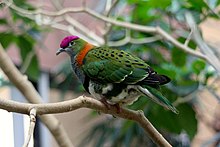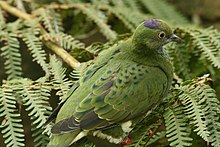Superb fruit dove
| Superb fruit dove | |
|---|---|

| |
| Male at London Zoo | |
| Scientific classification | |
| Domain: | Eukaryota |
| Kingdom: | Animalia |
| Phylum: | Chordata |
| Class: | Aves |
| Order: | Columbiformes |
| Family: | Columbidae |
| Genus: | Ptilinopus |
| Species: | P. superbus
|
| Binomial name | |
| Ptilinopus superbus (Temminck, 1809)
| |

The superb fruit dove (Ptilinopus superbus), also known as the purple-crowned fruit dove (leading to easy confusion with the
Description

It is sexually dimorphic. Males are superbly coloured with a fiery orange nape, green ears, and a purple crown. The breast is grey, and divided from the abdomen by a wide, dark blue band. Their wings are olive green covered with dark spots, and the tail is tipped with white. Females are mostly green, with a white abdomen, blue wing tips, light blue breast, and a small, dark blue spot on the back of the head. Both sexes have yellow eyes and eye-rings. Despite its colourful plumage, the superb fruit dove is well-camouflaged amongst the rainforest foliage.
Range
Native to Australasia, the superb fruit dove lives in the rainforests of New Guinea, Australia, Solomon Islands, the Philippines and Sulawesi of Indonesia. In Australia, it is found from southern New South Wales around the town of Moruya and extends further north, where it becomes more common to Cape York in Queensland. In some areas of its range, such as the New Guinean rainforest, it is a resident bird; in more marginal or seasonal habitats such as those in Australia, flocks are known to move about according to the availability of food.[2]
Diet
The superb fruit dove feeds primarily upon fruits and berries. In the
Behaviour
Superb fruit doves' wings whistle when they fly, and their call is a steady coo-coo-coo-coo.
The breeding season lasts from September to January. A small platform of twigs is built 5–30 metres off the ground, in which the female lays one small, white egg. She
Conservation
Habitat loss is a primary threat, but the superb fruit dove is still fairly widespread and common throughout its large range. The
References
- ^ . Retrieved 13 November 2021.
- ^ a b Frith, H.J.; Crome, F.H.J.C.; Wolfe, T.O. (1976). Food of Fruit-Pigeons in New Guinea. Emu 76(2): 49-58. HTML abstract
- ^ New South Wales Threatened Species. (2005). Superb Fruit Dove. Retrieved April 16, 2007, from http://threatenedspecies.environment.nsw.gov.au/tsprofile/profile.aspx?id=10709

